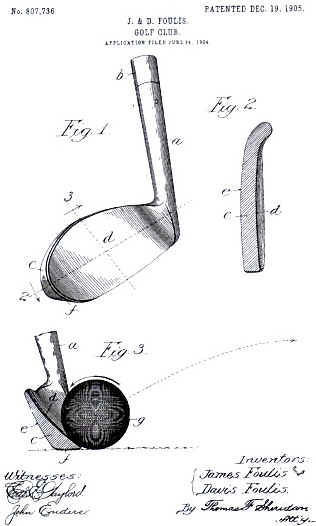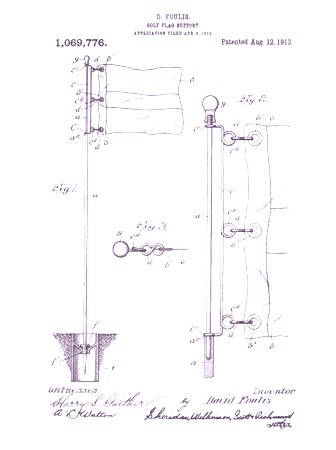Dave
Foulis - Greenkeeper Extraordinaire
One of those people that goes quietly about making life better. As time passes their influence almost always felt by those along their path, though rarely thought about until one looks beyond the surface. David along with his brother James, (1896 US Open Champion) , were full time golf professionals with a desire to bring about and experience constant improvement.
| This trait made its first
public appearance in form of the American Eagle golf ball, which was a
result of the invention of the gutta percha ball. The story goes
that when the gutta ball was introduced it was clearly a superior ball
(especially cost) in every respect except distance.
One day after having beaten a few dozen guttas to near death the Foulis boys noticed that as the gutta percha balls took on the nicks and bumps from the repeated poundings there shots had more air time and traveled further when well struck. As these balls were molded it was a fairly simple process to add a few bumps to a mold and the Foulis's decided to do so, choosing a pattern of stars for which they immediately file patent application. Less than 2 months later on March 21, 1899, they were issued their patent, number 30378 and the American Eagle golf ball was born. Information about the American Eagle Golf Ball beyond its invention and patent is hard to come by. What is known is that David and James patented their golf ball and they identified their design as "a spherical golf-ball with a series of encircling stars on its outer surface. A is the spherical golf-ball, and B the series of encircling pointed stars on its outer surface, the whole presenting to the eye a harmonious and ornate figure." So if you find yourself hawking for lost golf balls in the Chicago area and come across an old ball with a raised star pattern, odds are you have found a Foulis American Eagle |
|
Although we do not know much about the success of the Foulis's American Eagle golf ball we do know that it was short lived as a little more than 2 years after James and David received their patent Coburn Haskell was granted his for the Haskell Golf Ball. Although its popularity was slow to develop, when Sandy Herd beat the great Harry Vardon and James Braid at the Royal Liverpool using a Haskell Ball for all 72 holes the gutta was doomed.
|
|
James and David however continued their quest to improve the game and their next invention, though by it's name lasted only about 35 years, the concept is still a huge part of the early 21st century game. The Foulis's designed a new golf club and called it a "mashie-niblick". It is generally defined as a club that takes design aspects from a mashie (which is close to today's 5 iron) and a niblick ( which is close to today's 9 iron ). This commonly leads many to say then the "mashie-niblick" is like our 7 iron. Well yes it is however, and this is a big however that is not what the creation of the Foulis's club is all about. To grasp the full impact the "mashie-niblick" had on the game of golf you really need to take a closer look. The Foulis brothers emigrated from St. Andrews Scotland. James had learned his golf from Old Tom Morris and played many a match on the Old Course. As many know the original approach shot played not only at The Old Course but links courses every where was the "bump and run". Thus, golf clubs, quoting from the mashie-niblick patent application, "it is well known were made in such a manner that when the struck ball contacts the ground it continues to roll in the direction in which it has been driven." Now after playing on the inland park type courses of greater Chicago James and David found when they were hitting these shots hard enough to reach the green, this type of shot would "often resulted in overrunning the putting green." Now after saying "this sucks" a few hundred times to each other they decided that "It is therefore very desirable to provide a golf-club, which we prefer to term a "mashie-niblick," that will have all the advantages of the usual mashie and at the same time will enable the player to "hold' the ball back.....and in some instances to roll backward and travel, all of which will be understood and appreciated by those skilled in the art. (of golf)" So the next time you hit your 7 iron into a tight pin and the ball does a little dance and stops dead you can thank James and David Foulis for their insight into the game and what it was to become. |
The "mashie-niblick" was the last patent to bear the names of both James and David together, there is to be one to bear David Foulis's name. This one patent was like none before it and what it covered is still in use today.....throughout the world. David filed application on April 5, 1912 for a Golf Flag Support. Now to us in the early 21st century this may not seem like much but let's get into the time frame and application for patent a bit and see if it helps us understand a little more about golf and its concerns 1913 style.
The first documented use of golf flags as hole identifiers dates to May 1857 when at the spring meeting of the Royal and Ancients in St. Andrews it was decided to adopt Old Tom Morris's idea of using colored flags to identify the incoming and outgoing holes on the Old Course's double greens. The system was simple, white flags for the out holes, red for the in. The Flags were attached to shafts of some kind and the shafts in turn were stuck into the hole, probably just jammed into the dirt at the bottom, although Old Tom may have been using his hole liners by then so may be the flags were left to lean against the liners. The thought of the damage done to the cups must give green keepers night mares even now just to think about it.
Other courses adopted this idea as it was very popular with golfers for many reasons. Like all good things just starting there were a couple problems ranging from the flags wrapping around the shafts in high winds making them near impossible to see, and therefore useless. Then there was the problem of them being blown over in the wind due to the lack of a suitable base. I'm only guessing that the blowing over problem was "solved" by sticking the shaft deeper into the ground. The wrapping flag problem was often either left alone, or the cloth flags were replaced with "metal flags". For sure these did not wrap around the shafts however, as all golfers know not everyone gently lays the flag upon the green when they remove it from the hole. Result significant damage to both the putting greens and the metal flags.
Now with this background let's take a look at Foulis's most famous patent application....."The principal object of my invention to provide a simple economical and efficient golf flag support, of such construction and arrangement that the flag may be blown in any direction in which the wind is blowing without any danger of being wound around the supporting shaft..." interesting but "metal flags" solved the problem remember ? "There are many objections to the metal flag, the principal being (1) that in handling, that is in removing the flag from them hole cup, the player usually lays it on the grass or turf - more often throwing it down - which results in cutting or injuring of the turf; (2) that it (the turf) is expensive to make in the first instance and to repair afterward; and (3) that the flag itself if liable to be injured and become a distorted unsightly object." If you play golf today, on 99.9% of the golf course you see the result of this thought process. A golf flag that that does not wrap itself around the "flagstick", serves as a clear indicator of the hole location on the putting green and provides the golfer with correct knowledge as to which direction the wind is blowing at the location of the hole. On top of all this, even though the flag stick may damage the turf when thrown to the ground, the cloth flag will not. Now to sticking the flagstick in the hole, "To hold the flag in position and in the hole cup.....This arrangement permits the flag pole to be easily inserted and held in the desired vertical position, and at the same time without in any way tending to injure the cup." A search of US Patents quickly reveals the significance of this little golf course gem as it is referred to dozens of times with many feeble attempts to "improve upon it". All you have to do to understand in genius and timelessness is walk onto to 99.9% of the golf courses in the world and examine the flag stick with this drawing in mind. Truly one of the great golf inventions of all time. |
|
To learn more about other golfing inventions or golf related patents, continue your search here.....

